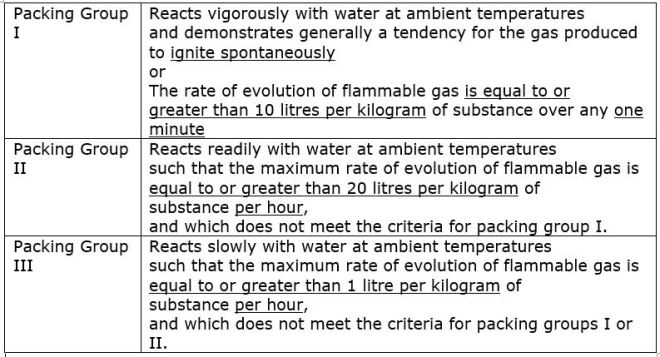Water, water, everywhere, And all the boards did shrink; Water, water, everywhere, Nor any drop to drink.”
= The Rime of the Ancient Mariner
Transport regulations classifies substances (solids and liquids) which, by interaction with water, are liable to become spontaneously flammable or to give off flammable gases in dangerous quantities under Class 4.3.
Some of these substances may emit flammable gases which forms explosives mixtures with air and can be ignited with even an unprotected light bulb.
The decision logic for classification of Class 4.3 is based on Test methods are given in the United Nations Manual of Tests and Criteria, part III, 33.4.1.
1. Occurrence of spontaneous combustion at any step during the test, or
2. At least 1 litre of flammable gas is generated by per kilogram of substance in an hour.
An example of Class 4.3 is ‘CALCIUM CARBIDE’, when in contact with water or moisture in air calcium carbide rapidly evolves acetylene, a highly flammable gas, which may be ignited by the heat of the reaction.
According to news reports the infamous ‘Tianjin Blast’ involved vast quantities of calcium carbide.
Another chemical under Class 4.3 is ‘ALUMINIUM PHOSPHIDE’ which is also toxic. Aluminium Phosphide when in contact with moist air or water evolve phosphine, a spontaneously flammable and highly toxic gas.
Pesticides made from aluminium phosphide falls under Class 6.1, toxic, however it will still evolve deadly phosphine gas. The rate of production is lesser than the classification criteria of Class 4.3.
All substances under Class 4.3 must be packed in hermetically sealed packagings. And certain solid substances permitted in bulk containers must be under a nitrogen blanket.
Packing Group for Class 4.3 is assigned on basis of reaction to water and rate of evolution of flammable gas as per below table.

Shipboard Emergencies: if a package or container carrying Class 4.3 is on fire the firefighting is to be carried out as per FIRE SCHEDULE Golf.
General comments: In a fire, exposed cargoes may explode or their containment may rupture. Fight fire from a protected position from as far away as possible. Use of copious quantities of water at once is recommended to cool down the heat radiation of the fire and to cool down heated cargo nearby. Only as a secondary effect, water will start or intensify burning of that material. Do not use small quantities of water – this will react strongly.
On Deck Container on Fire: If the fire is not igniting nearby cargoes, let the fire burn. Otherwise, cool the burning transport unit with copious quantities of water. Try to avoid getting water into the container.
Under Deck Container on Fire: Stop ventilation and close hatches. The fixed gas fire-extinguishing system should be used. If this is not available: Do not use water onto the material in enclosed spaces under deck. With open hatches, cool nearby cargo with copious quantities of water, although the fire could intensify for a short period of time. Do not spray small quantities of water onto the fire, use copious quantities of water.
Special Firefighting Media: LITHIUM, non-pyrophoric and MAGNESIUM POWDER require the use of dry Lithium chloride or dry sodium chloride or graphite powder to extinguish the fire. Do NOT use water or foam.
Response to spillage on board ships are divided into different categories of Class 4.3 substances as below.
- Spontaneously Combustible, Water-Reactive Substances
- Hazard of Spontaneous Ignition
- Substances Reacting Vigorously with Water
- Substances Dangerous When Wet (Non-Collectable Articles)
- Substances Dangerous When Wet (Collectable Articles)
Class 4.3 label is upper half symbol of flame (black or white), figure ‘4’ in bottom corner and background “blue”. The colour blue signifies dangerous reaction with water.

There are substances which are outside the classification criteria of Class 4.3 but still dangerous when carried in large quantities such as Direct Reduced Iron (DRI). Direct Reduced Iron is classified as “MATERIAL HAZARDOUS IN BULK” under The International Maritime Solid Bulk Cargoes (IMSBC) Code.
